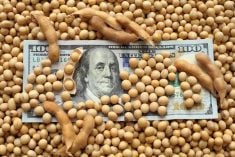San Diego | CNS Canada –– Weaker commodity prices and less international competition are expected to lend demand and profitability to the U.S. ethanol market in 2017, one analyst says.
But changing political and policy environments — in the U.S. and abroad — add an element of uncertainty to the market, and the potential to hinder the flow of demand.
“The central question for the ethanol industry today is how to grow demand,” said Scott Richman, senior vice-president at Informa Economics, speaking Wednesday at the National Ethanol Conference in San Diego.
Read Also

U.S. grains: Soy futures post biggest monthly gain in nearly five years on China trade optimism
U.S. soybean futures climbed to a 15-month high and posted their biggest monthly gain in nearly five years on Friday following a rally fueled by the prospect of revived exports to China.
The Renewable Fuel Standard (RFS) no longer provides enough demand to meet the rate of production, and that’s where export markets come in, he added.
Key drivers for global ethanol demand this year include commodity prices in the feedstock and energy sectors.
Prices for U.S. corn are expected to stay moderate throughout the year — granted the country does not see a significant weather problem — Richman said, which allows ethanol to stay cost-competitive.
Change in China’s target price program, in lieu of a minimum price program, and state auctions serve to bolster the ethanol market, he said.
On the energy side, ethanol is a competitive octane source. Low crude oil and gasoline prices reduce discretionary import demand and export prices, while there are high relative prices for octane internationally and in the U.S.
Last year, Brazil and Canada were the top two export markets, said Richman, with both countries purchasing roughly equal volumes.
“Canada has long been a steady customer,” while Brazil is a lot more volatile, he said.
But demand from Brazil is expected to be strong this year, and the country is expected to produce less competing supplies, as conditions in the country favour sugar production over ethanol.
The global sugar market is expected to be in its second deficit year, while mills are maximizing the sugar share of crush.
China is the third biggest market, Richman said, adding that demand from the country “came from nowhere two or three years ago.”
Policy shifts in the U.S. and in export markets could throw a sense of uncertainty into the ethanol market, which he said is a “political commodity.”
Near-term uncertainty in the U.S., as final 2017 rule making is under review by the country’s new administration, could shift the market’s dynamics.
That new leadership also poses the potential for trade conflicts in key ethanol markets, including Canada.
U.S. President Donald Trump has said he is looking to renegotiate the North American Free Trade Agreement (NAFTA), which could throw an element of turbulence into the market, affecting ethanol sales.
Trade with China has also been a hot button issue, and the U.S. government has levers to hinder ethanol imports, Richman said.
Policies within China, including government control of fuel distribution and the potential for increased domestic production, could also affect the U.S. market.
Looking forward, while not in the current year, he pointed to several emerging markets with “significant potential” in the long term, including Mexico, Japan and South Korea.
— Jade Markus writes for Commodity News Service Canada, a Winnipeg company specializing in grain and commodity market reporting. Follow her at @jade_markus on Twitter.











